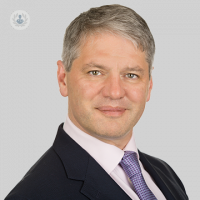HIFU, the new way to treat varicose veins (part one)
Escrito por:HIFU stands for “High-Intensity Focused Ultrasound”. Basically, it is a completely non-invasive way to treat structures under the skin, by beaming ultrasound through the skin itself. Ultrasound is sound waves but at a very high frequency so humans can’t hear it.
Just like sound, ultrasound is vibration energy and NOT radiation or any other sort of energy. As such, it doesn’t have the risks and worries of x-rays or other radioactive radiations. Professor Mark Whiteley and his team at The Whiteley Clinic are the first to use HIFU to treat varicose veins and venous leg ulcers, among other conditions.
How does HIFU work?
The echotherapy machine has two ultrasound parts. The first part is a simple ultrasound that gives an image of the tissue. This is the same as an ultrasound that is used to see a baby before it is born, or to look for gallstones. In this, low energy ultrasound is passed into the tissue and the machine picks up echoes to make a picture. This ultrasound spreads out just like sound from a speaker.
The second part is the HIFU. This is a dome that vibrates very fast, producing a “cone” of ultrasound energy. This ultrasound has a high intensity – i.e.: the vibration carries a lot of energy. However, the energy level is precisely engineered so that there is not enough energy to damage tissue near to the HIFU dome.

However, this “high intensity” ultrasound is also “ focused” as it is produced by a dome. The cone of ultrasound energy concentrates all of the energy at the tip of the cone. At this point, enough energy is concentrated in one place to heat a small amount of tissue, enough to kill it. This area is precise and is 3.6 mm in diameter.
By using the first ultrasound to see the veins under the skin, it can be used to precisely aim the HIFU cone of energy – meaning that a 3.6mm area of tissue can be destroyed deep under the skin, without any damage to the skin and surrounding tissue. It really is like Star Trek!
What is HIFU used for?
HIFU has been used to treat nodules and tumours in the thyroid and breast. In 2018, a French company called Theraclion decided to see if it could be used to treat varicose veins. Fifty cases were done by Albert Obermeyer in Austria to see if it worked. It did and so echotherapy for varicose veins using the "Sonovein" machine gained a CE Mark.
Theraclion then brought the machine to Prof Mark Whiteley of The Whiteley Clinic in the UK to start clinical trials in patients. Mark was the first doctor in the UK to treat varicose veins with endovenous surgery back in 1999. Since then he has introduced and developed many new treatments for varicose veins and venous conditions.
Therefore, he was selected to be the first in the world to use echotherapy HIFU in real patients with varicose veins and venous conditions, using the Sonovein machine. Currently, it is only used in The Whiteley Clinic and is not available anywhere else in the world.
How many HIFU treatments are needed for varicose veins?
The problem with varicose veins is that they have many underlying causes. This is explained fully in the book " Understanding Venous Reflux: the cause of varicose veins and venous leg ulcers ."
Therefore, it is impossible to generalise how many treatments might be needed. Any patient with varicose veins or any other venous conditions such as venous leg ulcers, venous eczema or brown staining around the ankles, needs to have an expert venous duplex ultrasound scan performed by a vascular technologist.
When this is done by a Whiteley Clinic trained vascular technologist using The Whiteley Protocol, the technologist can see if HIFU is appropriate and, if it is, how many sessions might be needed. As one of the leading vein units in the world, if HIFU is not suitable, an effective alternative will be available using The Whiteley Protocol.
Learn all about the advantages and disadvantages of HIFU for varicose veins in part two of this article.


